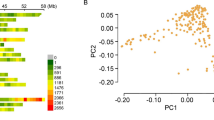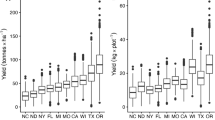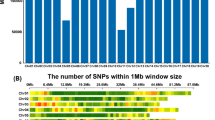Abstract
Understanding genetic diversity, population structure, and the level and distribution of linkage disequilibrium (LD) in target populations are of great importance and the prerequisite for association mapping. In the present study, 145 genome-wide SSR markers were used to assess the genetic diversity, population structure, and LD of a set of 95 maize inbred lines which represented the Chinese maize inbred lines. Results showed that the population included a diverse genetic variation. A model-based population structure analysis subdivided the inbred lines into four subgroups that correspond to the four major empirical germplasm origins in China, i.e., Lancaster, Reid, Tangsipingtou and P. Among all of the inbred lines, 65.3% were assigned into the corresponding subgroups; others were assigned into a “mixed” subgroup. LD was significant at a 0.01 level between 63.89% of the SSR pairs in the entire sample and with a range of 18.75–40.28% in the subgroups. Among factors influencing LD, linkage was the major cause for LD of SSR loci. The results suggested that the population may be used in the detection of genome-wide SSR marker–phenotype association.






Similar content being viewed by others
References
Andersen JR, Schrag T, Melchinger AE, Zein I, Lübberstedt T (2005) Validation of Dwarf8 polymorphisms associated with flowering time in elite European inbred lines of maize (Zea mays L.). Theor Appl Genet 111:206–217
Botstein D, White RL, Skolnick M, Davis RW (1980) Construction of a genetic linkage map in man using restriction fragment length polymorphisms. Am J Hum Genet 32:314–331
Camus-Kulandaivelu L, Veyrieras JB, Madur D, Combes V, Fourmann M, Barraud S, Dubreuil P, Gouesnard B, Manicacci D, Charcosset A (2006) Maize adaptation to temperate climate: relationship with population structure and polymorphism in the Dwarf8 gene. Genetics 172:2449–2463
Ching A, Caldwell KS, Jung M, Dolan M, Smith OSH, Tingey S, Morgante M, Rafalski AJ (2002) SNP frequency, haplotype structure and linkage disequilibrium in elite maize inbred lines. BMC Genet 3:1–14
Corder EH, Saunders AM, Risch NJ, Strittmatter WJ, Schmechel DE, Gaskell PC Jr, Rimmler JB, Locke PA, Conneally PM, Schmader KE, Small GW, Roses AD, Haines JL, Pericak-Vance MA (1994) Protective effect of apolipoprotein E type 2 allele for late onset Alzheimer disease. Nat Genet 7:180–184
Flint-Garcia SA, Thornsberry JM, Buckler ES (2003) Structure of linkage disequilibrium in plants. Annu Rev Plant Biol 54:357–374
Flint-Garcia SA, Thuillet AC, Yu JM, Pressoir G, Romero SM, Mitchell SE, Doebley J, Kresovich S, Goodman MM, Buckler ES (2005) Maize association population: a high-resolution platform for quantitative trait locus dissection. Plant J 44:1054–1064
Gupta PK, Rustgi S, Kulwal PL (2005) Linkage disequilibrium and association studies in higher plants: present status and future prospects. Plant Mol Biol 57:461–485
Huttley GA, Smith MW, Carrington M, Brien SJ (1999) A scan for linkage disequilibrium across the human genome. Genetics 152:1711–1722
Knowler WC, Williams RC, Pettitt DJ, Steinberg AG (1988) Gm 3;5,13,14 and type 2 diabetes mellitus: an association in American Indians with genetic admixture. Am J Hum Genet 43:520–526
Kraakman AT, Niks RE, van den Berg PMMM, Stam P, van Eeuwijk FA (2004) Linkage disequilibrium mapping of yield and yield stability in modern spring barley cultivars. Genetics 168:435–446
Li Y, Du J, Wang TY, Shi YS, Song YC, Jia JZ (2002) Genetic diversity and relationships among Chinese maize inbred lines revealed by SSR markers. Maydica 47:93–101
Li XH, Yuan LX, Li XH, Zhang SH, Li MS, Li WH (2003) Heterotic grouping of 70 maize inbred lines by SSR markers. Sci Agric Sin 36:622–627
Li Y, Shi YS, Cao YS, Wang TY (2004) Establishment of a core collection for maize germplasm preserved in Chinese National Genebank using geographic distribution and characterization data. Genet Resour Crop Evol 51:845–852
Liu KJ, Muse SV (2005) PowerMarker: integrated analysis environment for genetic marker data. Bioinformatics 21(9):2128–2129
Liu KJ, Goodman M, Muse S, Smith JS, Buckler E, Doebley J (2003) Genetic structure and diversity among maize inbred lines as inferred from DNA microsatellites. Genetics 165:2117–2128
Matsuoka Y, Mitchell SE, Kresovich S, Goodman M, Doebley J (2002) Microsatellites in Zea—variability, patterns of mutations, and use for evolutionary studies. Theor Appl Genet 1:436–450
Peng ZB, Liu XZ, Fu JH, Li LC, Huang CL (1998) Heterotic groups and patterns of maize inbred lines established by RAPDs. Acta Agron Sin 24:711–717
Pritchard JK, Wen W (2004) Documentation for STRUCTURE software. The University of Chicago Press, Chicago
Pritchard JK, Stephens M, Donnelly P (2000a) Inference of population structure using multilocus genotype data. Genetics 155:945–959
Pritchard JK, Stephens M, Rosenberg NA, Donnelly P (2000b) Association mapping in structured populations. Am J Hum Genet 67:170–181
Rafalski A, Morgante M (2004) Corn and humans: recombination and linkage disequilibrium in two genomes of similar size. Trends Genet 20:103–111
Remington DL, Thornsberry JM, Matsuoka Y, Wilson LM, Whitt SR, Doebley J, Kresovich S, Goodman MM, Buckler ES (2001) Structure of linkage disequilibrium and phenotypic associations in the maize genome. Proc Natl Acad Sci USA 98:11479–11484
Saghai-Maroof MA, Soliman KL, Jorgensen RA, Allard RW (1984) Ribosomal DNA spacer-length polymorphisms in barley: mendelian inheritance, chromosomal location and population dynamics. Proc Natl Acad Sci USA 81:8014–8018
Schuelke M (2000) An economic method for the fluorescent labelling of PCR fragments. Nat Biotech 18:233–234
Sharbel TF, Haubold B, Mitchell-Olds T (2000) Genetic isolation by distance in Arabidopsis thaliana: biogeography and postglacial colonization of Europe. Mol Ecol 9:2109–2118
Stich B, Melchinger AE, Frisch M, Maurer HP, Heckenberger M, Reif JC (2005) Linkage disequilibrium in European elite maize germplasm investigated with SSRs. Theor Appl Genet 111:723–730
Stich B, Maurer HP, Melchinger AE, Frisch M, Heckenberger M, van der Voort JR, Peleman J, Sørensen AP, Reif JC (2006) Comparison of linkage disequilibrium in elite European maize inbred lines using AFLP and SSR marker. Mol Breed 17:217–226
Stich B, Melchinger AE, Piepho HP, Hamrit S, Schipprack W, Maurer HP, Reif JC (2007) Potential caused of linkage disequilibrium in a European maize breeding program investigated with computer simulations. Theor Appl Genet 115:529–536
Sun SM, Li SM, Zheng ZR, Guo BT, Sun ZL, Wang B, Zhang CL, Weng ML (1999) Evaluation of the genetic relationships among basic maize inbred lines in Shangdong. Acta Agron Sin 25:727–732
Templeton AR (1995) A cladistic-analysis of phenotypic associations with haplotypes inferred from restriction-endonuclease mapping or DNA-sequencing. 5. Analysis of case-control sampling designs—Alzheimer’s-disease and the apoprotein-E locus. Genetics 140:403–409
Teng WT, Cao JS, Chen YH, Liu XH, Jing XQ, Zhang FJ, Li JS (2004) Analysis of maize heterotic groups and patterns during past decade in China. Sci Agric Sin 37:1804–1811
Thornsberry JM, Goodman MM, Doebley J, Kresovich S, Nielsen D, Buckler ESIV (2001) Dwarf8 polymorphisms associate with variation in flowering time. Nat Genet 28:286–289
Vigouroux Y, Jaqueth JS, Matsuoka Y, Smith OS, Beaviset WD, Stephen J, Smith C, Doebley J (2002) Rate and pattern of mutation at microsatellite loci in maize. Mol Biol Evol 19:1251–1260
Wang YB, Wang ZH, Lu LX, Wang YP, Zhang X, Tian ZY (1998) Studies on maize germplasm base, division of heterosis groups and utilizing models of heterosis in China. J Maize Sci 6(1):9–13
Wang YB, Wang ZH, Wang YP, Zhang X, Lu LX, Tian ZY (1999) The improvement of principal maize germplasm and utilization of heterosis model in China. J Maize Sci 7(1):1–8
Wang YD, Duan MX, Xing JF, Wang JD, Zhang CY, Guo JL, Zhao JR, Chen SJ (2004) Current situation and prospect of using P maize group to improve the heterosis utility and to development new germplasm. J Maize Sci 12(2):10–12
Whitt SR, Buckler ESIV (2003) Using natural allelic diversity to evaluate gene function. Methods Mol Biol 236:123–139
Wilson LM, Whitt SR, Ibanez AM, Rocheford TR, Goodman MM, Buckler ESIV (2004) Dissection of maize kernel composition and starch production by candidate gene association. Plant Cell 16:2719–2733
Xie CX, Zhang SH, Li MS, Li XH, Hao ZF, Bai L, Zhang DG, Liang YH (2007) Inferring genome ancestry and estimating molecular relatedness among 187 Chinese inbred lines. J Genet Genomics 34:738–748
Xie CX, Warburton M, Li MS, Li XH, Xiao MJ, Hao ZF, Zhao Q, Zhang SH (2008) An analysis of population structure and linkage disequilibrium using multilocus data in 187 maize inbred lines. Mol Breed 21:407–418
Yu YT, Wang RH, Shi YS, Song YC, Wang TY, Li Y (2007) Genetic diversity and structure of the core collection for maize lines in China. Maydica 52:181–194
Yuan LX, Fu JH, Zhang SH, Liu XZ, Peng ZB, Li XH, Warburton M, Khairallah M (2001) Heterotic grouping of maize inbred lines using RFLP and SSR markers. Acta Agron Sin 27:149–156
Zheng SY, Wang SC, Liu DZ (2006) Heterotic grouping of maize inbred lines classified by using SSR markers. J Maize Sci 14(5):26–29
Acknowledgments
The authors thank Dr. Chenyang Hao for technical support, Prof. Jizeng Jia and Xueyong Zhang for advice. We are also grateful to Zhizhai Liu and Ronghua Guo for their kind assistance and suggestions. The research was partly supported by the projects of the Ministry of Science and Technology (2006CB101700), the National Natural Science Foundation (30571133), the Ministry of Agriculture (nb07-070401) and the Beijing Agricultural Innovative Platform - Beijing Natural Science Fund Program (Yzpt02-06).
Author information
Authors and Affiliations
Corresponding authors
Additional information
Communicated by J. Yu.
R. Wang and Y. Yu contributed equally to the work.
Electronic supplementary material
Below is the link to the electronic supplementary material.
Rights and permissions
About this article
Cite this article
Wang, R., Yu, Y., Zhao, J. et al. Population structure and linkage disequilibrium of a mini core set of maize inbred lines in China. Theor Appl Genet 117, 1141–1153 (2008). https://doi.org/10.1007/s00122-008-0852-x
Received:
Accepted:
Published:
Issue Date:
DOI: https://doi.org/10.1007/s00122-008-0852-x




